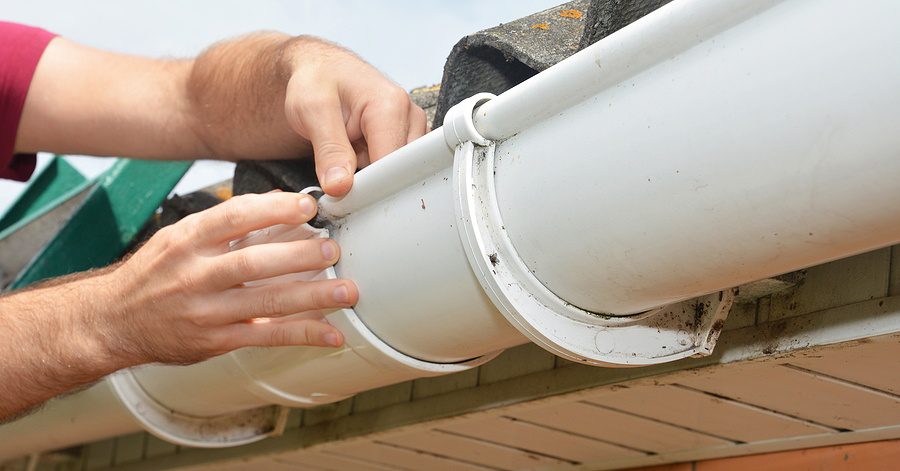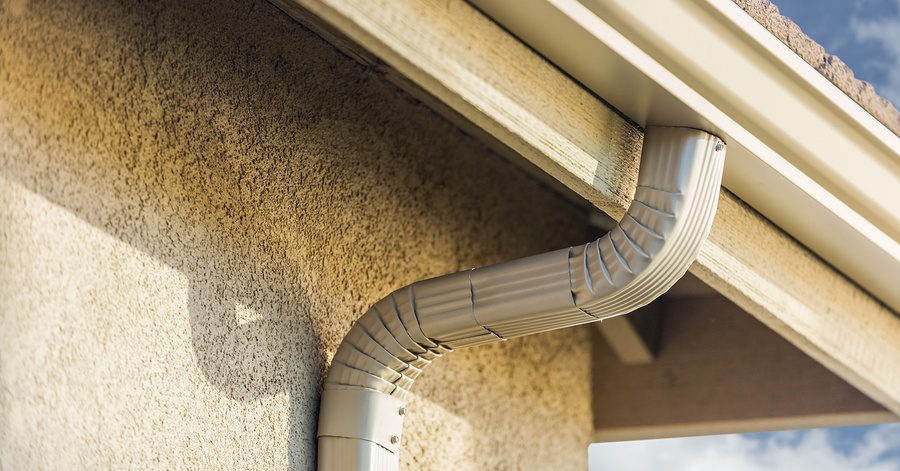How to Determine the Right Gutter Size for Your Home

If you’re getting ready to install gutters, you’re probably wondering what size will fit your home. Too small of a gutter system will clog quickly, causing water to overflow onto your home and soil. Too large of a gutter system, and you’ll find yourself forking over more cash than you needed to. Keep reading to discover why your gutter size matters and how we can help find the perfect fit.
Why Does Gutter Size Matter?
Gutters are supposed to catch and channel water away from your home. They also catch a lot of leaves, twigs, and other types of debris that make clogs more likely to occur. The problem with an undersized gutter system is that debris will build up and clog really fast.
If you’re dealing with frequent clogs and water problems, it could be a sign your gutters are too small. Oversized gutters aren’t necessarily problematic, but they’ll cost you a lot more than you need to spend. Plus, they’ll end up looking like a garment that’s two sizes too large.

Gutter Sizing Questions to Ask Yourself
The size of your gutters is determined by a few factors. When sizing your gutters, ask yourself questions like:
What is the size of my roof?
How much water volume am I anticipating?
Does my area get a lot of rainfall?
How many feet of roof eaves does my home have?
Standard Gutter Styles & Sizes
Ned Stevens Gutter Cleaning of Long Island offers two types of standard gutter installations:
K-style gutter systems and half-round gutter systems.

K-Style
K-style gutters are a popular choice among homeowners thanks to their durability and affordability. In fact, they’re the most popular gutter style in the United States. These gutters have a flat-back design, making them simple to install and effective at channeling water with minimal risk of leaking.
What Sizes Do They Come In?
A K-style gutter system typically comes in five-inch and six-inch sizes.
What Size Roof Are They Best For?
These gutters are appropriate for roofs with large square footage, such as commercial buildings and bigger homes. We recommend a K-style gutter system for roofs that are over 8,000 square feet.
Downspout Sizes
If you have a standard, five-inch K-style gutter system, 2X3 or 3X4-inch downspouts should suffice. If you have a six-inch K-style gutter, you should choose 4X5-inch downspouts.
Added Benefits
K-style gutters are more durable than other gutter types, are less prone to leaking, and can be fully customized to fit your home.

Half-Round
Half-round gutters are a popular choice for homeowners with historic homes. As the name suggests, half-round gutters have a rounded bottom—a charming style choice that not only boosts curb appeal but enhances their functionality. Half-round gutters can hold and flow more water than their K-style counterparts, making gutter cleaning a breeze.
What Sizes Do They Come In?
Half-round gutters are available in the same standard sizes as K-style gutters. You can find five and six-inch half-round gutters as well as larger seven and eight-inch gutters.
What Size Roof Are They Best For?
A half-round gutter system will comfortably fit a roof area of up to 3,850 square feet. If your roof is 2,500 square feet or less, you should choose a five-inch half-round gutter system.
Downspouts Sizes
Round downspouts are ideal for half-round gutters. These downspouts are available in three-inch, four-inch, five-inch, and six-inch diameters; if you have a six-inch half-round gutter system, we recommend choosing the six-inch downspout.
Added Benefits
Half-round gutters are made from durable materials that are less likely to rust. They’re also aesthetically pleasing and will potentially increase the value of your home if you choose to sell.
When You Need Larger Gutters
Even though it's recommended not to go bigger, there are a few instances where bigger gutter systems make sense. Your home or business can benefit from a seven or eight-inch gutter system only if it has a tile roof with the tile set above the roofline. In this case, it’s smart to go bigger.

Downspouts
You can’t have a complete gutter system without downspouts. Downspouts are essential for flowing water away from your property, keeping your soil and foundation free from any water damage. We recommend placing a downspout on your property per 30 feet of gutters.
How to Calculate Gutter Size
Now that you know why gutter size matters, you’re probably wondering how to calculate the right gutter size for your property. Here’s a tip: calculating your roof’s square footage is the most important part of finding the perfect gutter size.
Note the square footage of your home’s footprint, and find the pitch of your roof. Once you’ve established the pitch, multiply your home’s footprint accordingly to find adjusted square footage:
If a 6/12 pitch or below, multiply footprint by 1.15
If a 7/12 pitch to a 9/12 pitch, multiply footprint by 1.2
If a 10/12 to 12/12 pitch, multiply footprint by 1.3
If you’re struggling to calculate your roof area, contact Ned Stevens Gutter Cleaning of Long Island. We’ll help establish your roof area and determine the best gutter size for you.
Wrong Gutter Size Issues
Too small of a gutter system will lead to some pretty big problems. If the wrong gutter size has been installed, you may start to experience issues like overflows, wood rot, and leaks. The smaller the gutter system, the harder it is for water to flow through it. If water can’t flow freely from your property, you’ll eventually find yourself dealing with sopping wet soil, mold issues, and even structural damage.
Pitch the Perfect Gutters With Ned Stevens Gutter Cleaning of Long Island
We understand calculating your gutter size isn’t the easiest thing to do, especially if math isn’t your strong suit. Since 1998, Ned Stevens Gutter Cleaning of Long Island has been helping homeowners just like you. Whether you’re interested in K-style or half-round gutters, our team is here to make sure you get the best gutters right off the bat.

